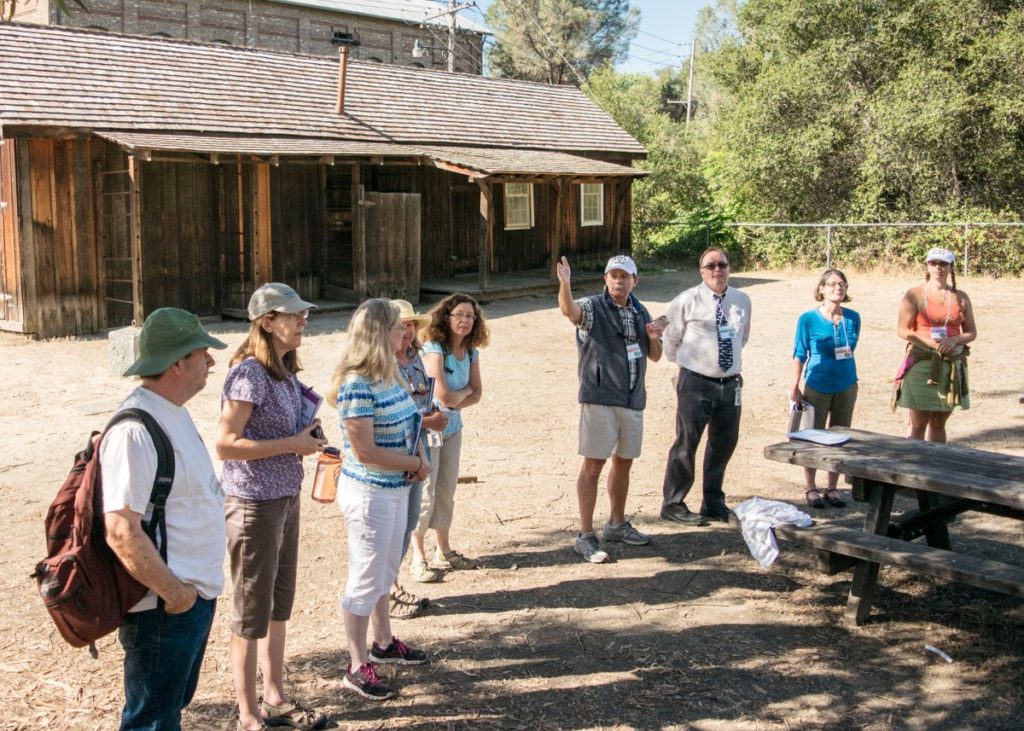History and Development of the Get Outside Workshops
In early 2012, the California State Board of Education was on the brink of adopting the Next Generation Science Standards (NGSS)—standards that would radically change how teachers would approach teaching science to their students. Anticipating the need for teacher support while transitioning to NGSS (which was adopted in 2013), the USC Sea Grant community of practice (CoP) in Los Angeles recognized that California’s Environmental Principles & Concepts (EP&Cs), and the Principles of Ocean Literacy (POL), provided an ideal pathway to design, organize, and facilitate place-based teacher training workshops.
The year-long initiative, called Environmental Literacy: One Ocean, led by Linda Chilton of USC Sea Grant and Heal the Bay’s Tara Treiber, offered district teams time, content area expertise, and ongoing support as they built integrated units of study that used the local environment as context for learning. The project proved extremely effective, with more than 70% of teacher participants still using the environment and the ocean as their context for teaching traditional subject areas. An especially gratifying outcome has been that many of the participating teachers extended their class lessons into environmental justice efforts, which help to close achievement gaps and increase access to outdoor environmental learning.
Five years later and with NGSS now a reality, teachers continue to enjoy the refined fruits of these earlier collaborations. They are evolving into true NGSS teacher leaders by using the EP&Cs and POL to go beyond the three dimensions of NGSS, and they are getting outside and integrating environmental principles across traditional subject lines.
Our CoP has evolved too, and expanded to include the California Coastal Commission (CCC) and California Project Wet (PWet), while resting on solid, established foundation at USC Sea Grant and the Wrigley Institute of Environmental Studies.
Promising New Developments
2017 marks a distinct opportunity to invigorate public education, specifically to elevate environment- and ocean-based science learning. This exciting momentum is driven by dramatically increased recognition of the value of outdoor and environmental learning in education policy.
This new opportunity is made vividly clear by the inclusion of the Environmental Principles and Concepts (EP&Cs) in California’s new Science Framework, and instructional strategies that state: “Outdoor and environmental learning experiences are powerful tools for implementing key instructional shifts required by the CA NGSS.” Now is the time to redefine “field trips,” to elevate the role that teachers play in outdoor education, and to integrate outdoor learning into the everyday practice of formal teaching.
Given these favorable conditions, the question is: How do we support classroom teachers to become effective outdoor instructors? How do they gain the skills and the strategies to keep students academically productive? How can environmental literacy avoid being “one more thing to do?”
My Journey
Some years ago I sought to improve my own outdoor instructional skills and ability to design effective instructional sequences, which could integrate outdoor learning into formal academic learning about natural systems. My implementation of the BEETLES Program strategies from the Lawrence Hall of Science, and a persistent integrative approach to instructional planning, brought that goal to fruition over two years of effort. From my own experience in the classroom, student interest in science increased; discretionary reading among 8th grade boys increased 17%, and girl’s participation in STEM projects (as long as they had outdoor components) doubled. Field trips were redefined into engaging field-science projects, ultimately becoming the foundation of our fully-integrated middle school science program. In my current role as a professional learning leader and NGSS transition advisor, I continue to use BEETLES strategies, EP&Cs and POL tools from the California Coastal Commission with teachers at that began early in 2016.
Basic Structure of “Get Outside with NGSS” Workshops
Sponsored by the National Park Service, USC Sea Grant, and Project Wet, the workshop series Get Outside with NGSS (GONE) supports teachers as they learn how to integrate the outdoors into effective instructional sequences, while using California’s EP&Cs and NOAA’s Principles of Ocean Literacy as teaching tools for learning about natural systems.
The workshop series features a simple, results-based structure:
- Experience: First, we jointly experience a 90-minute, phenomena-driven learning sequence that is thematically and physically grounded in a natural setting that students can easily access (e.g., schoolyards or a city, state, or national park). For example, at a park service ranch in the Santa Monica Mountains, we used the Malibu Creek Watershed to directly engage with nature in oak woodlands and riparian zones. This year, I am using coastal settings in partnership with the Coastal Commission.
- Analysis: After a break, we analyze the sequence with respect to outdoor learning practices and the three dimensions of NGSS’s. We put an emphasis on making connections through conversation, conceptual modeling for conveying evidence-based thinking, and nurturing student questioning.
- Application: Once the learning sequence’s goals and activities have been identified, named, challenged, and understood, we apply this knowledge. In groups of 2–3, participants plan their own learning sequence incorporating outdoor learning, ocean science content, and the natural systems emphasized by the EP&Cs.
- Fun: After lunch we practice outdoor learning routines in small groups with partners such as the National Parks Service, Coastal Commission, and Natural History Museum of Los Angeles (NHMLA). These tips from experienced outdoor educators provide practical insights into how to assess risks, manage student groups in the outdoors, and connect outdoor learning to pre- and post-teaching.
In my next blog, I will describe a detailed, step-by-step itinerary of how these points connect to create the actual Get Outside with NGSS workshop – in a way that you will hopefully be inspired to join and replicate yourself!





